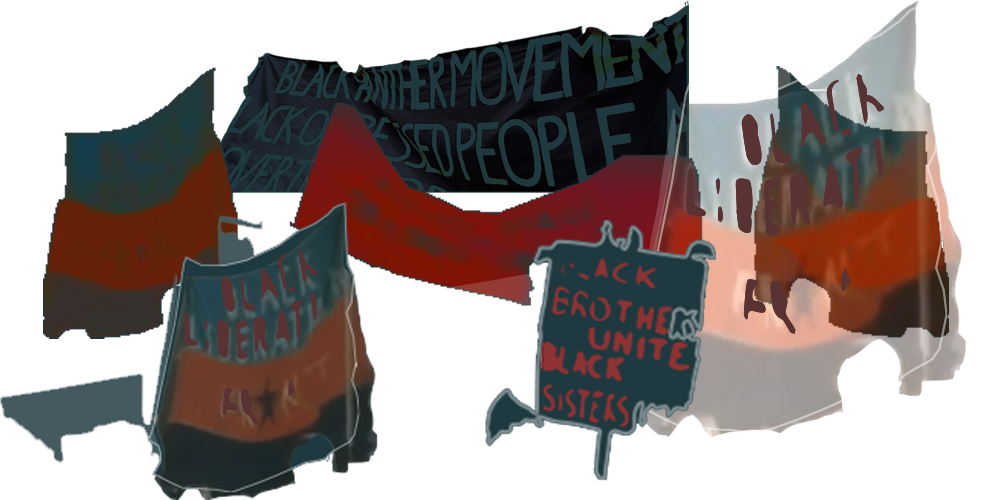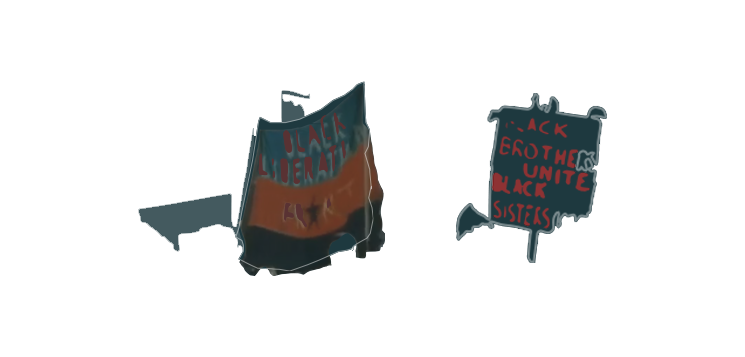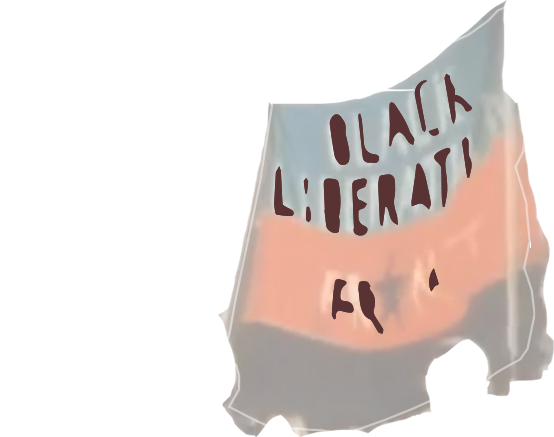Clive Chijioke Nwonka
The Public
and Private
Black Archive

In viewing the landmark
film Blood a go Run (Dir Menelik Shabazz, 1981) that captures the Black
Peoples Day of Action March in protest at the New Cross Fire of 18 January 1981
and the police racism that underpinned the official apathy towards the murder
of 13 young Black people in the house blaze [ Figure 1 - 09:31 * ], we are presented with a
body of images that recruit both public and intimate associations held within
the text that connect, reconnect and inform us of the identifiable history of
Black Britain, and attend to the more private, subjective but also collective Black
experiences [Figure 2 - 00:15 * ]. In attempting to describe such an interpretation as
born from an instinctive archival practice, I in many ways am offering an
example of how Black film texts situated in history equally make a register on
the contemporary. My intellectual work has been and remains concerned with this
exploration of the intertextual and inter-dimensional underpinnings of
representations of Black identity through the idea of Black film and visual
culture and the aesthetic, cultural and political discourses and that
constitute and inform it. [Figure 3 - 12:20 * ]






To describe such a
sequence above on its own as an archive would be to perform a particular neglect,
for there is a complex dynamic involved in the production of Black film and
moving image that have previously been described as organised by a
‘triangulation of ownership’ (Nwonka & Saha, 2021). Here, there is a description
of how Black textualities produced under the auspices of public funding and its
associated ideologies and attachments are equally a site of contestation amongst
its institutional funders, its authors, and crucially, its audiences. Thus, my
interest is in an ever-evolving nature of Black cinematic imagery, which
includes the various visual documentations of Black Britain and beyond. This is
a Black filmic archive that is not only populated by the physical images and
image streams of Black identity that are presented to us within text itself,
but by the equally unsettled and often unpredictable social and cultural
responses the texts provoke. It is an outcome not just of the text itself, but
what it produces culturally. [Figure 4 - 09:51 * ] By this, I’m referring to the responses
these texts, drawn from and contributing to the material documents of Black British
identity, generate amongst its Black and non-Black audiences, socially,
politically and artistically.



Much of the contemporary
engagement with Black visual culture and its various products exhibits a
similar relationship with the archival practice that I’ve described above.
However, I accept that such archival practices and the physical artefacts
contained within them produce often different meanings and registers as Black
visual culture and history becomes hyper visible as the subject of academic and
non-academic analysis, engagement, and interpretation. Indeed, this has become
the question that informs much of my analytical and research interests not just
in the politics of the productions of images of Blackness but in questions of
affect, spectatorship and how such texts accrue often divergent meanings once
circulated within a society, conjunctural moment or/and within the racial wake.
My academic and non-academic writing on Black film displays the combinational outcome of such archival practice. Specifically, in reflecting on my research for the piece ‘Burning an Illusion: Landmark and Legacy’, for the Black Film Bulletin (2022) where I explored the legacy of the late Menelik Shabazz’s landmark film Burning an Illusion (1981), the film’s account of South London’s young Black community encourages us to open up to a broader archive of texts that are concerned with bringing in a Black audience to within the visual sphere of collective Black cultural memory, one that is resourced by the physical artifacts, materials and visualities of Black creative and authorial imagination, representation and identity. Further, I’ve explored the alchemistic affect of the Black visual artist/filmmaker John Akomfrah’s Handsworth Songs (1986), a landmark documentary film that used radical cinematic approaches in rejecting the hegemony of documentary realism that marked dominant media’s framing of the Black experience for a more avant garde, poetic realism to understand the Black political uprisings in Birmingham the previous year. Here, I engage with the possibility that in the continuous public revisitation of the film, the atemporality of the text is to be identified not in the relationships we can identify in the Black British experience from then and now, but how radical Black film practices can be described as such through the rejection hegemonic modes of Black textual representation. in doing so, it can produce a continuous sensorial and interventional affect on the Black diasporic community.
More recently, we find an example of this idea of the Black film text as a site for the engagement with the Black film text as a public archive of Black history and the Black present in the Steve McQueen BBC anthology series Small Axe (2020), which across its 5 texts displays its own Black archival practice in the narrational chronologising of Black political history in the depicting of the factual events and biographies that speak to the West Indian condition in Britain, a visual and narrational manifesto most exemplified in the series’ first film, Mangrove (2020) and its revisitation of the story of the Mangrove restaurant in Notting Hill and the subsequent Mangrove Nine trial [Figure 5]. My research engages not just with the film’s representations of Black resistance against a violent technology of anti-Black policing, but also allows an entry point into the kinds of textual analyses that nuances the definition of the film as a biopic, and how its sjuzhet, crafted from the images and narratives archival materials and Black political literatures equally render the film as an adaptation; its reliance on the existing literatures and narratives archived in Black British history.
My academic and non-academic writing on Black film displays the combinational outcome of such archival practice. Specifically, in reflecting on my research for the piece ‘Burning an Illusion: Landmark and Legacy’, for the Black Film Bulletin (2022) where I explored the legacy of the late Menelik Shabazz’s landmark film Burning an Illusion (1981), the film’s account of South London’s young Black community encourages us to open up to a broader archive of texts that are concerned with bringing in a Black audience to within the visual sphere of collective Black cultural memory, one that is resourced by the physical artifacts, materials and visualities of Black creative and authorial imagination, representation and identity. Further, I’ve explored the alchemistic affect of the Black visual artist/filmmaker John Akomfrah’s Handsworth Songs (1986), a landmark documentary film that used radical cinematic approaches in rejecting the hegemony of documentary realism that marked dominant media’s framing of the Black experience for a more avant garde, poetic realism to understand the Black political uprisings in Birmingham the previous year. Here, I engage with the possibility that in the continuous public revisitation of the film, the atemporality of the text is to be identified not in the relationships we can identify in the Black British experience from then and now, but how radical Black film practices can be described as such through the rejection hegemonic modes of Black textual representation. in doing so, it can produce a continuous sensorial and interventional affect on the Black diasporic community.
More recently, we find an example of this idea of the Black film text as a site for the engagement with the Black film text as a public archive of Black history and the Black present in the Steve McQueen BBC anthology series Small Axe (2020), which across its 5 texts displays its own Black archival practice in the narrational chronologising of Black political history in the depicting of the factual events and biographies that speak to the West Indian condition in Britain, a visual and narrational manifesto most exemplified in the series’ first film, Mangrove (2020) and its revisitation of the story of the Mangrove restaurant in Notting Hill and the subsequent Mangrove Nine trial [Figure 5]. My research engages not just with the film’s representations of Black resistance against a violent technology of anti-Black policing, but also allows an entry point into the kinds of textual analyses that nuances the definition of the film as a biopic, and how its sjuzhet, crafted from the images and narratives archival materials and Black political literatures equally render the film as an adaptation; its reliance on the existing literatures and narratives archived in Black British history.
![[Figure 5]](https://freight.cargo.site/t/original/i/766d7e500a3635b49d7897a3242e4413f2173e5f86b99c9fa075b48b235b59a5/Flag_04-Figure-5.png)
To endeavour to
research these texts, however, is to accept that this is a public archive that
is conditioned by a form of open access; by this, I’m gesturing to the ways in
which the popular distribution of Black film - as a public archive – also
invites the non-Black allure in the pleasures of Black visual identity and
culture, particularly the most culturally satisfying aspects of Black cultural
production that manifest as a convivial interest in the Black music forms that
emanate from Lover’s Rock (2020). This was the second instalment in the Small
Axe series and a film that produced a cross generational and crucially,
multiracial coalescing across social media on the themes of memory, love
accuracy and appreciation to be found in its representations of Jamaican soundsystem
culture. In examining specifically the public archive of Black film that finds
access points across both historical sites of consumption (television, cinema,
video, and gallery spaces) and new technologies that allow for the mass
distribution of Black content across digital platforms, we find that Black
cultural production, the academic study of it and the cultural attention paid
to it all function within the same sphere where Blackness remains vulnerable to
the commodification and objectification of Black British diasporic identity and
vernacular cultures.
The other archive, or archival practice if you will, that remains central to my intellectual work is how one cannot simply identify but must explore and consider the origins and meanings of the representations of Blackness/anti-Blackness through moving images and its related mediums. This is an archival practice that finds its presence, somewhat paradoxically, in the fissures between the public and the private. Specifically, I am referring to the arche of Black cultural memory that is constructed upon the private intimacies of Black emotion in the images, media, reportage and narrative accounts of the racist murder of the 18-year-old Black teenager Stephen Lawrence, who on 22 April 1993 would be stabbed to death by six white youths at a bus stop Eltham, Southeast London. [Figure 6 - Stephen Lawrence]. This murder, which remains at the very centre of our both deep and nascent visceral understandings of fatal anti-Blackness and a reminder of the violent post-colonial conditions faced by Black people that continue to disturb the fabulations underpinning the official practice and portraiture of multiculturalism and its continuum, post-racialism, has over time created a body of archival material not solely located in the visual, or the dispersal of the kinds of imagery that would naturally be associated with the murder, but in its more official documentation that has necessitated an scholarly approach that can be described as both multi and inter-disciplinary. This has been influenced by the legacies of the 1999 Macpherson Report, the outcome of the public inquiry into his murder and the police investigation, which would finally accept and advance our long-experienced practice of ‘institutional racism’ to within the official lexicon. It is the seismic political tremors caused by the Stephen Lawrence family’s public campaign for justice and the image of Stephen that accompanied this struggle that has seared the murder into cross generational public consciousness.
The other archive, or archival practice if you will, that remains central to my intellectual work is how one cannot simply identify but must explore and consider the origins and meanings of the representations of Blackness/anti-Blackness through moving images and its related mediums. This is an archival practice that finds its presence, somewhat paradoxically, in the fissures between the public and the private. Specifically, I am referring to the arche of Black cultural memory that is constructed upon the private intimacies of Black emotion in the images, media, reportage and narrative accounts of the racist murder of the 18-year-old Black teenager Stephen Lawrence, who on 22 April 1993 would be stabbed to death by six white youths at a bus stop Eltham, Southeast London. [Figure 6 - Stephen Lawrence]. This murder, which remains at the very centre of our both deep and nascent visceral understandings of fatal anti-Blackness and a reminder of the violent post-colonial conditions faced by Black people that continue to disturb the fabulations underpinning the official practice and portraiture of multiculturalism and its continuum, post-racialism, has over time created a body of archival material not solely located in the visual, or the dispersal of the kinds of imagery that would naturally be associated with the murder, but in its more official documentation that has necessitated an scholarly approach that can be described as both multi and inter-disciplinary. This has been influenced by the legacies of the 1999 Macpherson Report, the outcome of the public inquiry into his murder and the police investigation, which would finally accept and advance our long-experienced practice of ‘institutional racism’ to within the official lexicon. It is the seismic political tremors caused by the Stephen Lawrence family’s public campaign for justice and the image of Stephen that accompanied this struggle that has seared the murder into cross generational public consciousness.


It is interesting to
reflect here on how the materials of the Black archive developed within one
domain (law, legislation and governance) impact upon another—the domain of cultural
policy and its inherent diversity politics (this being the ideological
permeation of the Labour government’s own construction of institutional
racism’s antithesis – racial inclusion). The neoliberal accumulation and redefinition
of racism/anti-racism, demonstrates at least one way of how the legacies of the
Stephen Lawrence’s murder have not just informed but constituted my academic
practice concerned with the post-racial phantoms found in the management of
racial difference performed by public cultural and creative institutions but, a
la Stuart Hall (1988), the texts they produce, and its reliance upon and
engagement with the degree of cultural politics present in everyday racial
discourse. However, it is the second instinctive engagement with the memory of
the murder of Stephen Lawrence as a private Black archive, this being our own communal
and internal image-laden recollections, oral histories and narratives that, in
many ways both brings the question of the specificity of academic discipline and
the reality of the more personal connection to the Black visual archive to a
point of convergence.
My interest in the potentialities of the private Black visual archive is propelled by being situated in an industrial context where the scholarly products of the Black visual archive are often devoid of any kind of explicatory work that exhibits a concern with the reality that academic practice as market insists that the dividends of Black archival research are disseminated far from the Black geographies from which such archival material is created and sourced, and crucially, accrue an individualised economic, cultural and industrial value that does not recirculate back to its original point of creation.
It is increasingly becoming true to me that the academic and non-academic study of Black identity, race and racialisation has moved from space of invisibility to one of liminality, where the still fugitive but tangible presence of Black scholarship and organised sites of teaching and learning within higher education has also been accompanied by the forms of verticality, patronage and extraction that mark our racialised conditions beyond academia. This, I feel, is a position that has been accelerated by both the struggle for the academic study and teachings of Black pedagogies, particularly Black British history and contemporaneity, and its subsequent and related hyper-celebration and aggrandising within popular culture only at the immediate moments of anti-Black injustice, Black mourning, and post-racial cultural visibility as anti-racist intervention (diversity).
Further, questions of positionality and self-reflexivity seldom venture beyond the immediate context of study; these are the essential but often absent questions of the very practice of studying Black visual culture and the Black life forms that are framed within it, and the ethical considerations that refer to the non-Black academic study of Black visual culture. Resultingly, the analysis of Black culture through both academic industrial practices (symposia, articles, conferences) and popular culture becomes an assumed but unexplored arena of racial conviviality, and by a further extension of this assumptive logic, horizontality and sameness. This is something that we observe in the academic entry into the public archive of Black history and the present, which are often entered into and gutted of its most valuable and private asset; authenticity, which is framed now as a simple decision of research methodology and the ways in which truthfulness, accuracy, representation and fidelity are determined through cultural and spatial proximity or a certain display of academic research rigour, be it from within the anthropological study of Black existences, the sociological collation and empirical analysis of Black conditions, or in more related field of research, the textual study of Black visuality and narration.
It may be that one way to circumvent this, as I have explored in other writings concerned with the glacial cohabitation between neoliberalism and Black culture and identity, is to recourse to the private arenas of Black identity and reciprocity in which the Black visual archive can be created, accessed, contributed to as well as drawn from. I remain invested in, both professionally personally, by the oral histories, narratives, memories and affects that are to be found within and evoked from the various images of Stephen Lawrence that spans both time and medium. I should stress that this approach, which in essence argues that the Black public archive and its items of Black visuality, history narrative, and cultural products of which academia aggrandises as a reliable entry point into Blackness for non-Blackness is not an affirmative methodology for an understanding of Black life, is not indicative of an absolutism in which Paul Gilroy cautions against in a descent into racially organised ‘camps’ (2000) but how the neoliberal university and its accumulative tendencies necessitates some degree of emotional and spiritual protection from the harmful extractive instincts of academia as a simple variant of capitalistic competitive economy where our Black histories, experiences, texts and narratives are often sourced and presented in ways that are absent of either ethics or proprietorship. This I believe, even within the permissive spaces of our academic departments and research centres and their underexamined claim to a space of public racial solidarity, is most undetectable within a claim to a shared, allied, and communal spaces of intellectual anti-racism found in the sociological, political, cultural and aesthetics study of Black identity, culture and conditions, of which academic research as the as the assumed high point of professional intellectual work engender.
With this in mind, the study of the production and consumption of Black moving images as just one iteration of this where I turn to the most private of postcolonial archives, Black cultural memory, asks that we draw our intellectual work from the more private realms of the Black communal traditions, locations and experience that inform Black visual narration and the circulation and recirculation of the images of Blackness that we lay claim to. I am unable to speak with any kind of affirmativism on how others, even within the above-described institutional sphere of academia, have approached this archival practice, or even if it is an archival practice in itself or simply an instinctive mode of Black being, is approached by others, for this is a nascent and evolving academic practice. But I do find that much of the intellectual influences that populate my own multidisciplinary approaches to the exploration of Black visual textuality are equally drawn from a similarly private archival space of Black cultural memory, which are, as argued, materially evoked. What I am describing is a mode of Black archival practice that functions in such a way that ensures that in the dispersal of our ideas, findings and analyses that the archives permit, our primary constituents and congregations are those very Black identities, communities and environments in which the archive is born, constituted and made valuable.
My interest in the potentialities of the private Black visual archive is propelled by being situated in an industrial context where the scholarly products of the Black visual archive are often devoid of any kind of explicatory work that exhibits a concern with the reality that academic practice as market insists that the dividends of Black archival research are disseminated far from the Black geographies from which such archival material is created and sourced, and crucially, accrue an individualised economic, cultural and industrial value that does not recirculate back to its original point of creation.
It is increasingly becoming true to me that the academic and non-academic study of Black identity, race and racialisation has moved from space of invisibility to one of liminality, where the still fugitive but tangible presence of Black scholarship and organised sites of teaching and learning within higher education has also been accompanied by the forms of verticality, patronage and extraction that mark our racialised conditions beyond academia. This, I feel, is a position that has been accelerated by both the struggle for the academic study and teachings of Black pedagogies, particularly Black British history and contemporaneity, and its subsequent and related hyper-celebration and aggrandising within popular culture only at the immediate moments of anti-Black injustice, Black mourning, and post-racial cultural visibility as anti-racist intervention (diversity).
Further, questions of positionality and self-reflexivity seldom venture beyond the immediate context of study; these are the essential but often absent questions of the very practice of studying Black visual culture and the Black life forms that are framed within it, and the ethical considerations that refer to the non-Black academic study of Black visual culture. Resultingly, the analysis of Black culture through both academic industrial practices (symposia, articles, conferences) and popular culture becomes an assumed but unexplored arena of racial conviviality, and by a further extension of this assumptive logic, horizontality and sameness. This is something that we observe in the academic entry into the public archive of Black history and the present, which are often entered into and gutted of its most valuable and private asset; authenticity, which is framed now as a simple decision of research methodology and the ways in which truthfulness, accuracy, representation and fidelity are determined through cultural and spatial proximity or a certain display of academic research rigour, be it from within the anthropological study of Black existences, the sociological collation and empirical analysis of Black conditions, or in more related field of research, the textual study of Black visuality and narration.
It may be that one way to circumvent this, as I have explored in other writings concerned with the glacial cohabitation between neoliberalism and Black culture and identity, is to recourse to the private arenas of Black identity and reciprocity in which the Black visual archive can be created, accessed, contributed to as well as drawn from. I remain invested in, both professionally personally, by the oral histories, narratives, memories and affects that are to be found within and evoked from the various images of Stephen Lawrence that spans both time and medium. I should stress that this approach, which in essence argues that the Black public archive and its items of Black visuality, history narrative, and cultural products of which academia aggrandises as a reliable entry point into Blackness for non-Blackness is not an affirmative methodology for an understanding of Black life, is not indicative of an absolutism in which Paul Gilroy cautions against in a descent into racially organised ‘camps’ (2000) but how the neoliberal university and its accumulative tendencies necessitates some degree of emotional and spiritual protection from the harmful extractive instincts of academia as a simple variant of capitalistic competitive economy where our Black histories, experiences, texts and narratives are often sourced and presented in ways that are absent of either ethics or proprietorship. This I believe, even within the permissive spaces of our academic departments and research centres and their underexamined claim to a space of public racial solidarity, is most undetectable within a claim to a shared, allied, and communal spaces of intellectual anti-racism found in the sociological, political, cultural and aesthetics study of Black identity, culture and conditions, of which academic research as the as the assumed high point of professional intellectual work engender.
With this in mind, the study of the production and consumption of Black moving images as just one iteration of this where I turn to the most private of postcolonial archives, Black cultural memory, asks that we draw our intellectual work from the more private realms of the Black communal traditions, locations and experience that inform Black visual narration and the circulation and recirculation of the images of Blackness that we lay claim to. I am unable to speak with any kind of affirmativism on how others, even within the above-described institutional sphere of academia, have approached this archival practice, or even if it is an archival practice in itself or simply an instinctive mode of Black being, is approached by others, for this is a nascent and evolving academic practice. But I do find that much of the intellectual influences that populate my own multidisciplinary approaches to the exploration of Black visual textuality are equally drawn from a similarly private archival space of Black cultural memory, which are, as argued, materially evoked. What I am describing is a mode of Black archival practice that functions in such a way that ensures that in the dispersal of our ideas, findings and analyses that the archives permit, our primary constituents and congregations are those very Black identities, communities and environments in which the archive is born, constituted and made valuable.
Bibliography
Hall, S (1988) New Ethnicities. Black Film British Cinema. ICA
Gilroy, P (2000) Between Camps: Nations, Cultures and the Allure of Race. Routledge
Nwonka, C, Saha, A (2021) Film, Culture and the Politics of Race (in) Black Film British Cinema II. MIT Press/Goldsmiths Publishing.
Nwonka, C (2022) Burning an Illusion: landmark and legacy. Black Film Bulletin/Sight and Sound, February 2022
Filmography
Blood ah go Run (Dir Menelik Shabazz, 1981)
Handsworth Songs (Dir John Akomfrah, 1986)
Mangrove (Dir Steve McQueen, 2020)
Lover’s Rock (Dir Steve McQueen, 2020)
Hall, S (1988) New Ethnicities. Black Film British Cinema. ICA
Gilroy, P (2000) Between Camps: Nations, Cultures and the Allure of Race. Routledge
Nwonka, C, Saha, A (2021) Film, Culture and the Politics of Race (in) Black Film British Cinema II. MIT Press/Goldsmiths Publishing.
Nwonka, C (2022) Burning an Illusion: landmark and legacy. Black Film Bulletin/Sight and Sound, February 2022
Filmography
Blood ah go Run (Dir Menelik Shabazz, 1981)
Handsworth Songs (Dir John Akomfrah, 1986)
Mangrove (Dir Steve McQueen, 2020)
Lover’s Rock (Dir Steve McQueen, 2020)
Dr Clive Chijioke Nwonka
Dr Clive Chijioke Nwonka is Associate Professor in Film, Culture and Society at UCL, and a Faculty Associate of the UCL Sarah Parker Remond Centre for the Study of Racism and Racialisation. Dr Nwonka’s research centres on the study of Black British and African American film, with a particular focus on the Black aesthetics, images of Black urbanity and the modes through which Black identities are shaped by representations of environments, architecture, social anxieties and the hegemony of neoliberalism within forms of Black popular culture. In addition, he has published extensively on racial inequality in the creative industries and ‘diversity’ policy frameworks that are equally born from broader political discourses on race, racism and cultural difference. Thus, Nwonka’s research is interdisciplinary and spans across Film Studies, literature, Cultural Studies, Black Studies and Sociology. Nwonka is the co-editor of the book Black Film/British Cinema II and is the author of the forthcoming books Black Boys: The Aesthetics of British Urban Film, and Black Arsenal: Race, Cultural Memory and Black British Identity (2023)
︎︎︎ ︎ ︎

This page was developed and designed in collaboration with
Kutlwano
Ramphele & Lele Ramphele of m’lk
︎︎︎ ︎ ︎ ︎
︎︎︎ ︎ ︎ ︎


